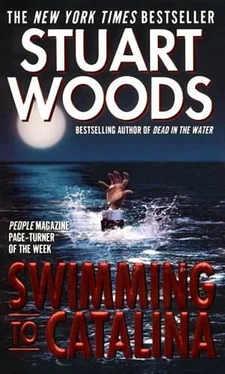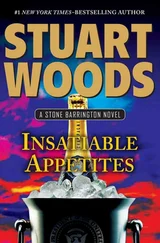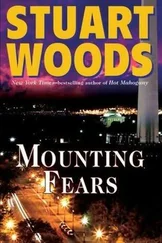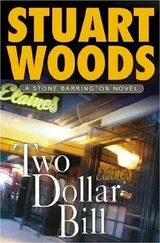Stone and Dino arrived at the Long Beach marina after midnight and found their rented boat. It was painted black, for which Stone was grateful, and it looked very fast indeed. They tossed their gear on board, then Stone handed Dino the duct tape. “Tape over the name of the boat wherever it’s painted on and also the Coast Guard numbers. We don’t want any trouble for Rick’s ex-brother-in-law later.”
Dino went to work while Stone got familiar with the boat and its equipment. He was delighted to find a Garmin GPS unit, which had a color screen that displayed all the land masses and buoys in the area. That would make navigating at night a lot easier. He switched on the VHF radio and tuned it to Channel 16; if the Coast Guard were patrolling the area, he wanted to hear them before they saw him.
He dug out a pair of life jackets from a locker and handed one to Dino. “Better put this on.”
“I spent a lot of time on Sheepshead Bay with my old man in his boat,” Dino said. “I’m a lot more comfortable in boats than in airplanes; I don’t need that.”
“Dino, we’re going to be traveling fast at night; if we hit something and capsize, we need the jackets. Put it on.”
Dino reluctantly got into the life jacket and adjusted it. “Happy now?”
“Not yet, but I’m planning to get a lot happier.” Stone double-checked everything, then started the engines. Dino let go their lines and, keeping the big engines at idle, Stone maneuvered out of the marina. A few minutes later they were on their way at thirty knots. “Keep a sharp lookout,” Stone said. “There are fishing boats out here this time of night towing nets and trawls. We want to give them a wide berth.”
“Right.” Dino said.
It was a lovely night, with many stars, clear of the usual smog. They were making a lot of wind with their speed, and Stone was glad to have the warmth of his weatherproof suit. Catalina loomed ahead.
Contessaturned out be easy to find. She was the biggest thing in the anchorage by far, and she was wearing a bright anchor light; her bow and stem lights were on, too. Stone throttled back while they were still three hundred yards out and made his way among the moored yachts and empty moorings. Not many people would be sleeping aboard the small boats during the week, and Stone was glad for that. As they approachedContessa, she seemed to get bigger and bigger.
“Jesus,” Dino said, “that’s some piece of work, that boat. How much you think it cost to build it?”
“I don’t know-eight, ten million dollars, I would guess. Depends on when she was built. These days, she’d cost a lot more.”
“Okay, you think you can tell me what your plan is now?”
“First I’m going to have to get the crew off.”
“How many?”
“Two, I think.”
“And what the fuck are we going to do with them?”
They were at the stern boarding ladder of the big yacht now, and Stone pointed up to the deck. “There’s a rubber dinghy up there; I saw it from the air. I’ll toss it down to you. We’ll put them in that and set them adrift; somebody will pick them up after daylight.”
“Okay, whatever you say.”
They cut the engines and tied the Whaler to a teak swimming platform on the stern. Stone stuffed the duct tape and the socket wrench kit into his jacket’s large pockets, climbed up the boarding ladder, and stuck his head above deck; there was no one in sight, but operatic music wafted from somewhere. The rubber dinghy was gone. Stone looked around for another tender, but all he saw were two large speedboats, slung in davits. Maybe somebody had gone ashore; he hoped so.
With his flashlight in one hand and his pistol in the other, Stone started forward toward the bridge. Along the way he looked into every port and window, watching for anyone stirring on the yacht, but he saw no one.
He climbed the stairs to the bridge and peeked in. There was one deckhead light on, and a radio was playing, but no one was in sight. Very slowly, he opened the door and stepped onto the bridge, the pistol out in front of him. There was no sound but the radio.
He carefully opened two doors on the bridge; one led to a stairway below, the other was, apparently, the captain’s cabin. A lamp was on, and the bed was mussed, but not unmade. He poked into the captain’s toilet, and that was empty as well. Surely the crew wouldn’t leave the big yacht entirely untended?
It seemed preposterous, but perhaps there really was no one aboard. He opened the door to the stairway and started slowly down, listening at every step.
0ne flight down, Stone looked into the large saloon and dining room, then into the galley. A light was on in there, and an open jar of mayonnaise with a knife stuck in it sat on a countertop. Looked as though someone had made a sandwich earlier.
Stone went back to the stairs and descended another flight. He could no longer hear the music now; there was only an unearthly silence. Surely the ship’s generators would be running. He bent down and placed a hand on the deck, feeling for vibration. Nothing. The ship must be on battery power. He walked down a hallway, still keeping quiet, and looked into every cabin, switching on a light in each. No one. Good.
Having searched the deck, he walked down another flight of stairs, where he found a door on either side of him. A sign on the one to his right readCREW QUARTERS. A sign on the other door readGUEST QUARTERS. The crew must be asleep instead of on watch, he thought.
He put the flashlight in his jacket pocket, set down the bag he was carrying, removed the roll of duct tape, opened the door to the crew’s quarters, and listened. Silence. Leaving the bag in the hallway, he checked every cabin and found no one. Bad crew, he thought, ashore drinking when there was an intruder on the yacht in their charge. He went through the other door and checked the guest cabins on that deck, finding them all empty.
Finally, he descended to the lowest deck and went into the engine room, switching on the lights. There were no ports in here, so no one could see the light from shore.
Now he had his work to do. He set down the bag, took out the socket wrench kit, and went to the nearest seacock. The valve was joined to the cooling water pipe by two flanges-one on the seacock and one on the pipe. He closed the seacock, selected the proper socket, and went to work on the six bolts holding the two flanges together. When he was done the two flanges remained stuck together with some sort of sealant, and he couldn’t pull them apart by hand. He’d come back to that.
He went to the seacock for the other engine and repeated the process, then turned to the big ones-the seaboxes. The two six-inch pipes rose vertically from the steel-plated deck, each capped by a steel plate that sealed the top of the pipe. Smaller pipes branched off the sides of the larger one, each with its own seacock. He closed all the valves, found the right socket, and removed the eight bolts securing the sealing plate to the top of the pipe. Water began to leak through the seal, but the plate remained in place. He left it there while he performed the same operation on the other seabox.
“Now,” he said aloud, “I’ve got to find something that will dislodge the sealant on each pipe, and I’m in business.” He looked around and saw a workbench nearby; he walked over to it, opened a closet adjacent to the bench, and found a selection of large tools. He chose a small sledgehammer with a three-foot handle.
He went to the first engine cooling pipe and fetched it several blows with the hammer. Gradually the sealant let go; then he repeated the action with the other engine’s pipe. He dropped the sledgehammer on the deck near the door, then went back to the workbench, found a chisel and a hammer, and went to work on the sealing plate of the starboard seabox. After his first blow, water began to squirt under high pressure; he hit it twice more. The plate flew off, and a six-inch column of water rose from the pipe, striking the deckhead. The noise, echoing off the steel plates, was deafening.
Читать дальше












